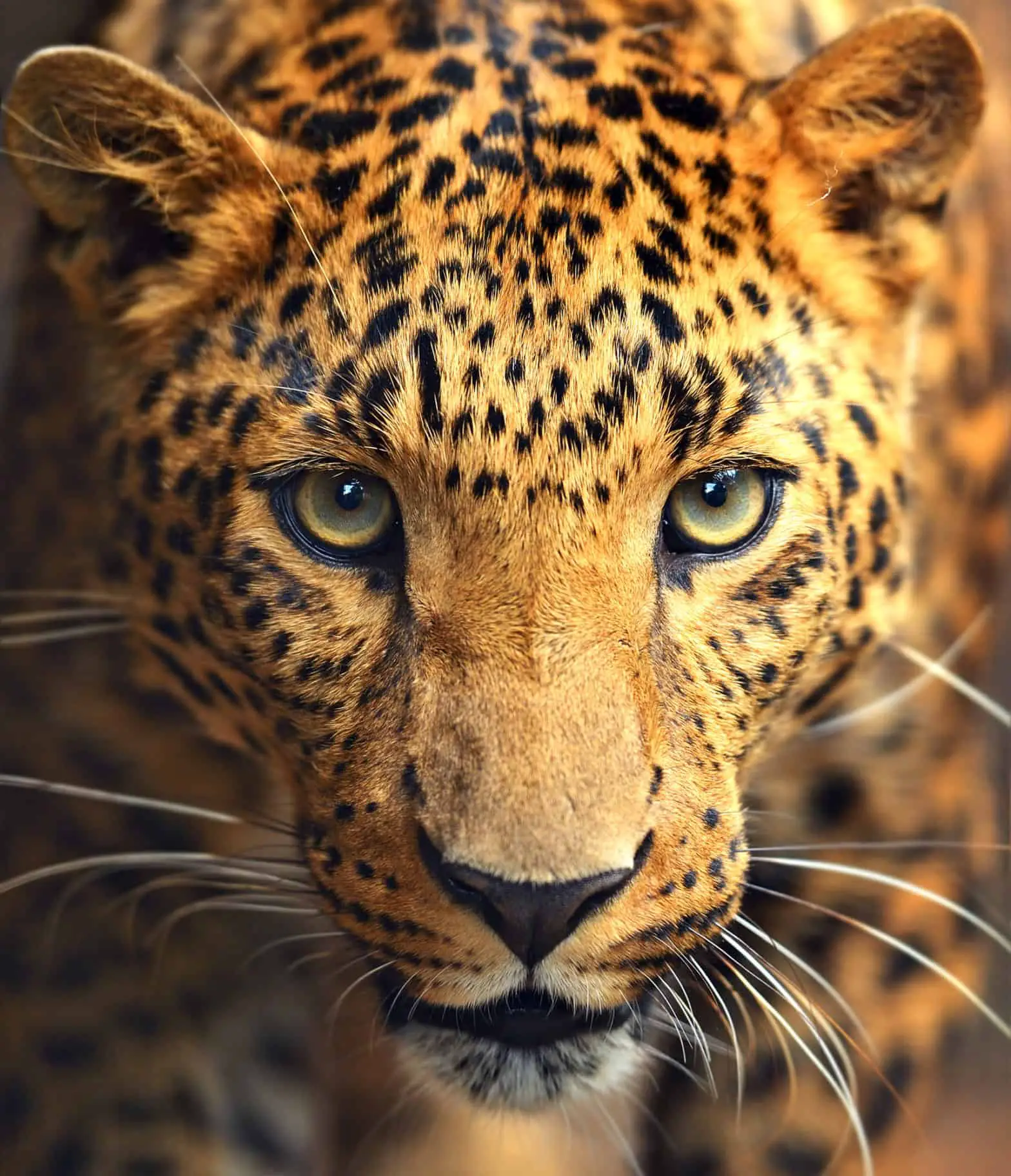Table of Contents
*This post may contain affiliate links. As an Amazon Associate we earn from qualifying purchases.
While lions and tigers are probably among the most commonly pictured when the words “big cat family” are mentioned, few members of this group are as beautiful yet diverse as the leopard.
The graceful, spotted wildcats can be found on two continents, Africa and Asia, with a few isolated subspecies remaining in Russia and China. The species includes seven different subspecies. These cats can vary widely in color, range, and habits. However, their numbers and habitats are shrinking every day, so understanding how they eat, breed and otherwise behave can be vital to conservation efforts that might help leopards in the wild survive and thrive.
What Are Leopards?
Leopards are a member of the big cat family that includes tigers, cheetahs, lions, and jaguars. Males can weigh nearly 200 pounds and reach top speeds of 30 mph while chasing prey. Unlike many other big cats, however, leopards are solitary and do not live in pride and other family groups.
They prefer to hunt at night and spend their days napping in treetops to evade danger. Their fur color ranges from gold to dark brown, although the black panther, which is the form of a leopard with a black coat, can also be found throughout the range. Leopards are carnivorous and hunt a wide variety of prey that includes different species of deer, wild hogs, birds, and rodents. It is this diverse diet that has allowed the leopard to survive, even as its habitat shrinks.
Leopards vs Jaguars
Some people often confuse leopards with jaguars. While both species are big cats, the two are vastly different and do not share the same habitat. The black panther is a leopard that sports an all-black coat or a very dark one with muted spots, and these species live in Asia and Africa. However, a black panther that lives in Central and South America is a jaguar, not a leopard. Some jaguar subspecies can also be found in North America, although populations in New Mexico and Arizona are not as large as they once were.
Mating and Cub-Rearing Habits
Once a young female leopard leaves its mother at about the age of 14–18 months, she establishes her own territory and is ready to reproduce once she reaches three years of age. Unlike some other mammals, female leopards may mate at any time of year, depending on the availability of males in the area. Once she mates, she will create a den in thick foliage or in other isolated areas of her habitat.
Kittens arrive after a three-month gestation period, and the mother keeps them well hidden from predators until they are strong enough to follow her as she hunts, about 10 weeks later. A mother leopard may have up to four kittens in one litter, although not all may survive to adulthood due to illness, accident or falling prey to other predators like large birds, snakes, and hyenas.
Kittens
Kittens that do survive are taught to hunt by watching their mother, who provides them with both milk and meat. Male kittens will be encouraged to leave the mother and strike out on their own around age two, while female leopards may stay in the range of their mother’s territory and eventually mate and have kittens of their own. Food supply and availability of territory may affect the size or overlapping of female leopards’ range.
Leopard Habitat
One reason leopards may be successful as a solitary predator is because of their wide range of habitats over two continents. While other predators may restrict themselves to wide-open plains or secluded forests, leopards can survive and even thrive in a variety of habitats that include marshlands, rainforests, jungles, mountain ranges and even desert climates.
Leopards typically prefer areas where there is plenty of tree cover. As they will often carry prey high into treetops to protect it from scavengers. These cats are strong enough to drag an entire deer or antelope into a tree. Where they may feed off it for days to preserve their energy until they must hunt again.
Territory
Once a leopard claims its territory, it has several ways of letting other leopards know about its presence. Scent marking is common. And a leopard will rub its scent glands on trees and other objects to mark the perimeters of its territory. Male cats use both urine and scent-gland marking. And while they may not roar as loudly as lions, they can produce a variety of different calls to let rival males know they are nearby. Most male leopards tend to roar and call at night. With the most common noise being a short, deep, raspy sound similar to a sudden cough.
Habitats
Due to its shrinking habitat, leopard habitats are commonly overlapping human ones. While these animals are highly adaptable and still manage to hunt and raise families near suburban locales, this puts them in a greater danger of being hunted and killed for several reasons. One of the most common reasons is that local farmers can see them as a threat to cattle. While other cats are killed for sport. Some are caught in traps and die from their injuries. While others are accidentally poisoned by bait left for other pests. While not all leopards that venture into human villages or cities are killed, the majority of them usually fall prey to a hunter’s rifle or some other death at the hands of humans.
Threats to the Species
Although leopards can still be found in the wild and roam over a variety of territories, their numbers are shrinking as their borders are forced closer to human populations. Deforestation due to the timber industry and expanding farmland and grazing requirements are two of the largest threats. As this decimates leopard habitat and forces them into each other’s territories. Some farmers protect their cattle by leaving out poisoned meat, while others shoot as many leopards as they can. In some cases, large sections of leopard territory are burned to make way for commercial growing space. Unfortunately, there are not many laws that protect the big cats. Because hunting limitations vary so widely from region to region.
Hunting and Poaching
Trophy hunting and poaching also threaten the leopard population. Hunting is still legal in some parts of Asia, where it is lawful to shoot and kill male leopards. Poaching takes a large number of big cats, especially in Africa, where an underground trade makes a leopard’s hide and teeth valuable commodities. One of the most startling practices is the trade of leopard heads. Which some hunters purchase on the black market to adorn their trophy room walls.
As a result, many subspecies of leopard, such as the Javan and Persian, are now almost nearly extinct. The Amur leopard, which used to be found throughout the forests of Russia and parts of China, now numbers only 60 animals. While this number is slightly higher than it was a decade ago, these leopards are still in critical danger of being permanently erased from the face of the earth.
Leopard Attacks: Fact Vs. Fiction
Leopards are commonly hunted because they perceive them as a threat to any humans who might be living nearby. While it is not common for leopards to attack or devour humans, they recorded some incidents. These attacks are most common in India. According to a 2009 Washington Post report, and the victims are usually young children. However, these incidents usually occur because of the close proximity of leopards to people and the domestic animals they keep. When food is scarce in the wild, leopards may encroach into cities to prey on goats, dogs, and other animals to survive. In truth, humans killed many more leopards than the other way around.
Man vs. Leopard
The crisis of man vs. leopard may reduce if certain efforts are taken to widen the big cats’ territories. When humans move in, attacks usually increase, especially the ones involved are children. Most leopards that become man-eaters must be exterminated. Because it is likely they will continue to take human prey once they understand how to reach and take it down. This is a sad fact and the result of the human population overtaking that of the solitary leopard.
Conservation: How You Can Help
Leopard conservation efforts are underway in many parts of the world. However, they require continued work if future generations are to appreciate and treasure these beautiful animals. If you want to become involved, there are a few actions you can take. Such as joining conservation groups that include the protection of leopards in their overall agenda. Discourage friends and family from supporting the trophy hunting industry and educate them about the declining leopard population. It is unlikely any leopards will survive into the next century. Unless humans take steps to preserve and support their numbers.
A Final Word
The leopard is one of the most unique of the big cats. And its ability to live in a variety of territories and on a vast array of prey has made it a successful predator. However, certain subspecies are in grave danger of going extinct unless they take immediate steps. Only then can these beautiful big cats survive and share our world.Featured image via Depositphotos

